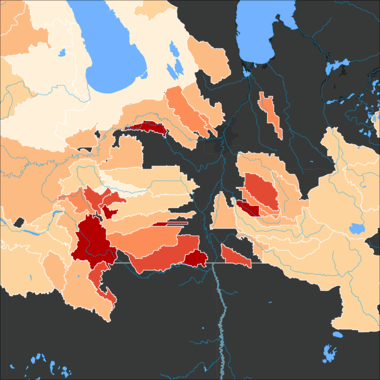LWCBMN data update

The Lake Winnipeg Community-Based Monitoring Network (LWCBMN) is designed to identify localized phosphorus hotspots within the larger Lake Winnipeg watershed. Based on provincial and federal monitoring data demonstrating that 70 per cent of Lake Winnipeg’s annual phosphorus load comes from the Red River, LWBCMN sampling activities have been focused in these basins, and have effectively identified recurring phosphorus hotspots where efforts to reduce phosphorus loading should be targeted.
Questions about the Winnipeg River
In recent years, as LWCBMN has expanded, we’ve noticed curious results along the Winnipeg River. According to the 2020 State of Lake Winnipeg report, the Winnipeg River contributes a much smaller proportion of the total phosphorus load to Lake Winnipeg than the Red River (14 per cent versus 70 per cent). We were surprised to see apparent hotspots occurring along the Winnipeg River – even in very dry years, when phosphorus loading was low across the entire network.
Suspecting that these unusual results might be an artefact of LWCBMN sampling or analysis procedures, we enlisted LWCBMN science advisors to review the data from sampling sites along the Winnipeg River.
How our dataset is changing
Based on that review, we’ve decided to remove all water samples collected from hydroelectric generating stations from our dataset. This includes samples collected at both Manitoba Hydro and Ontario Power Generation dams.
Dams create unique conditions which are very different from typical LWCBMN sampling sites. Hydroelectric dams, while not sources of phosphorus in and of themselves, may impact phosphorus dynamics along the river. In particular, dams can sequester phosphorus, holding it back in upstream reservoirs. So, phosphorus concentration will vary depending on where water samples are collected – upstream or downstream. This could have a significant impact on our results.
Timing of sample collection will also impact results. To accurately characterize phosphorus loading at a given site, LWCBMN samples must be collected frequently in response to changes in water flow. At hydroelectric generating stations, both dam operations and seasonal weather variation affect water flow. If sample collection isn’t timed to match these changes in flow, our calculations of phosphorus load may over- or under-estimate actual loads.
Additionally, the Winnipeg River is a huge river, contributing 43 per cent of the total water flow to Lake Winnipeg (compared to 12 per cent from the Red River). Our monitoring protocols are designed specifically for small creeks and streams, where we collect an integrated sample throughout the full depth of the water column. Our sample collection protocols may not be adequate to collect representative samples from much larger rivers.
Finally, our lab analysis, which we regularly test against other labs across the country, performs consistently well for the concentrations we’re measuring in the Red River watershed. But Winnipeg River phosphorus concentrations are an order of magnitude lower than those in the Red River basin – so low that we’ve had less opportunity to compare these results against those of other labs. We plan to undertake further tests to assess this.
LWCBMN is generating credible, useful data
We maintain strong confidence in the high-resolution, frequent and responsive sampling activities that LWCBMN undertakes in smaller creeks and streams within the Red and Assiniboine river basins. These community-based monitoring efforts are generating credible and useful data that would be difficult and costly for centralized monitoring programs to collect.
From the beginning, LWCBMN was designed to produce citizen-generated data that complements government water-monitoring programs in the Lake Winnipeg watershed. We plan to continue to work with our partners along the Winnipeg River to understand the unique challenges of sampling in this system. In addition to valuable water-flow data collected by both Manitoba Hydro and Ontario Power Generation, both Environment and Climate Change Canada and Manitoba Environment and Climate Change collect water samples to measure phosphorus concentration in the Winnipeg River.
It has always been our goal to bring together interoperable datasets from diverse and credible sources – government, industry and community-based – to strengthen our understanding of phosphorus loading to Lake Winnipeg. Hopefully, the Winnipeg River watershed offers us a first, important opportunity to integrate these complementary monitoring activities to enrich our understanding and point the way to collaborative solutions.